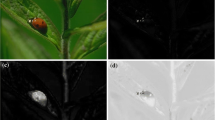Abstract
This paper represents a new level set method for multiregional image segmentation. It employs the Gabor filter bank to extract local geometrical features and builds the pixel tensor representation whose dimensionality is reduced by using the offline tensor analysis. Then multiphase level set functions are evolved in the tensor field to detect the boundaries of the corresponding image. The proposed method has three main advantages as follows. Firstly, employing the Gabor filter bank, the model is more robust against the salt-and-pepper noise. Secondly, the pixel tensor representation comprehensively depicts the information of pixels, which results in a better performance on the non-homogenous image segmentation. Thirdly, the model provides a uniform equation for multiphase level set functions to make it more practical. We apply the proposed method to synthetic and medical images respectively, and the results indicate that the proposed method is superior to the typical region-based level set method.
Preview
Unable to display preview. Download preview PDF.
Similar content being viewed by others
References
Adalsteinsson, D., Sethian, J.A.: A Fast Level Set Method for Propagating Interfaces. J. Comput. Phys. 118(2), 269–277 (1995)
BrainWeb: Simulated Brain Database, http://www.bic.mni.mcgill.ca/brainweb/
Chan, T.F., Vese, L.A.: Active Contours without Edges. IEEE Trans. Image Process. 10(2), 266–277 (2001)
Chan, T.F., Sandberg, B.Y., Vese, L.A.: Active Contours without Edges for Vector-Valued Images. J. Vis. Commum. Image R. 11(2), 130–141 (2000)
Daugman, J.G.: Two-Dimensional Spectral Analysis of Cortical Receptive Field Profiles. Vision Res. 20(10), 847–856 (1980)
Li, C., Xu, C., Gui, C., Fox, M.D.: Level Set Evolution without Re-initialization: A New Variational Formulation. In: IEEE Conference on Computer Vision Pattern Recognition, pp. 430–436. IEEE Computer Society Press, Washington (2005)
Lie, J., Lysaker, M., Tai, X.: A Binary Level Set Model and Some Applications to Mumford-Shah Image Segmentation. IEEE Trans. Image Process. 15(5), 1171–1181 (2006)
Mumford, D., Shah, J.: Optimal Approximations by Piecewise Smooth Functions and Associated Variational Problems. Commun. Pur. Appl. Math. 42(5), 577–685 (1989)
Malladi, R., Sethian, J.A., Vemuri, B.C.: Shape Modeling with Front Propagation: A Level Set Approach. IEEE Trans. Pattern Anal. Machine Intell. 17(2), 158–175 (1995)
Marcelja, S.: Mathematical Description of the Responses of Simple Cortical Cells. J. Optical Soc. Am. 70(11), 1297–1300 (1980)
Osher, S., Sethian, J.A.: Fronts Propagating with Curvature-Dependent Speed: Algorithms Based on Hamilton-Jacobi Formulation. J. Comput. Phys. 79, 12–49 (1988)
Peng, D., Merriman, B., Osher, S., Zhao, H., Kang, M.: A PDE Based Fast Local Level Set Method. J. Comput. Phys. 155(2), 410–438 (1999)
Sun, J., Tao, D., Papadimitriou, S., Yu, P.S., Faloutsos, C.: Incremental Tensor Analysis: Theory and Applications. ACM Trans. Knowl. Disc. from Data 2(3), 11:1–11:37 (2008)
Suri, J.S., Liu, K., Singh, S., Laxminarayan, S.N., Zeng, X., Reden, L.: Shape Recovery Algorithms Using Level Sets In 2-D/3-D Medical Imagery: A State-Of-The-Art Review. IEEE Trans. Inf. Technol. Biomed. 6(1), 8–28 (2002)
Tao, D., Li, X., Wu, X., Maybank, S.J.: General Tensor Discriminant Analysis and Gabor Features for Gait Recognition. IEEE Trans. Pattern Anal. Machine Intell. 29(10), 1700–1715 (2007)
Tao, D., Song, M., Li, X., Shen, J., Sun, J., Wu, X., Faloutsos, C., Maybank, S.J.: Bayesian Tensor Approach for 3-D Face Modelling. IEEE Trans. Circuits and Systems for Video Technology 18(10), 1397–1410 (2008)
Tao, D., Li, X., Wu, X., Maybank, S.J.: Tensor Rank One Discriminant Analysis - A Convergent Method for Discriminative Multilinear Subspace Selection. Neurocomputing 71(10-12), 1866–1882 (2008)
Vese, L.A., Chan, T.F.: A Multiphase Level Set Framework for Image Segmentation Using the Mumford and Shah Model. Int. J. Comput. Vision 50, 271–293 (2002)
Wang, Z., Vemuri, B.C.: DTI Segmentation Using an Information Theoretic Tensor Dissimilarity Measure. IEEE Trans. Med. Imaging 24(10), 1267–1277 (2005)
Zhao, H., Chan, T.F., Merrian, B., Osher, S.: A Variational Level Set Approach to Multiphase Motion. J. Comput. Phys. 127, 179–195 (1996)
Author information
Authors and Affiliations
Editor information
Editors and Affiliations
Rights and permissions
Copyright information
© 2009 Springer-Verlag Berlin Heidelberg
About this paper
Cite this paper
Wang, B., Gao, X., Tao, D., Li, X., Li, J. (2009). The Gabor-Based Tensor Level Set Method for Multiregional Image Segmentation. In: Jiang, X., Petkov, N. (eds) Computer Analysis of Images and Patterns. CAIP 2009. Lecture Notes in Computer Science, vol 5702. Springer, Berlin, Heidelberg. https://doi.org/10.1007/978-3-642-03767-2_120
Download citation
DOI: https://doi.org/10.1007/978-3-642-03767-2_120
Publisher Name: Springer, Berlin, Heidelberg
Print ISBN: 978-3-642-03766-5
Online ISBN: 978-3-642-03767-2
eBook Packages: Computer ScienceComputer Science (R0)




